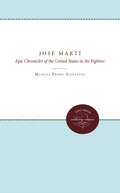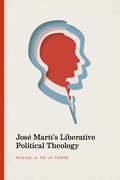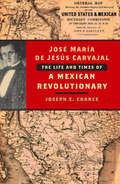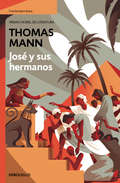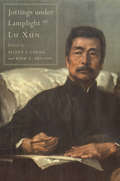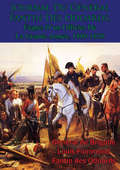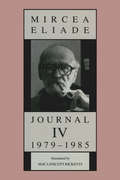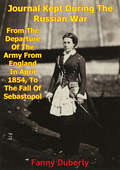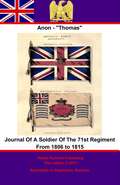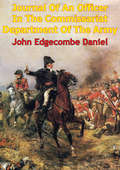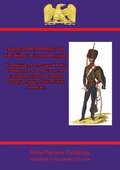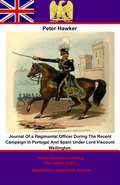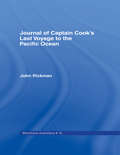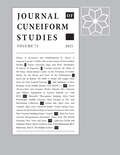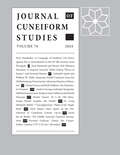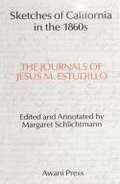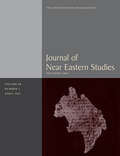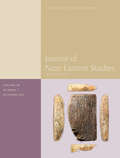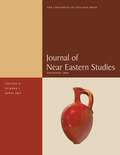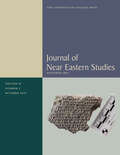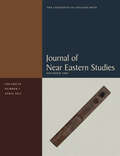- Table View
- List View
José Martí: Epic Chronicler of the United States in the Eighties
by Manuel Pedro GonzalezJose Marti, great Cuban patriot, wrote Spanish articles on the United States during the eighties. In the present sketch, the author has presented Marti to the country he interpreted so sympathetically and has made a living portrait of a rich and complex personality.Originally published in 1953.A UNC Press Enduring Edition -- UNC Press Enduring Editions use the latest in digital technology to make available again books from our distinguished backlist that were previously out of print. These editions are published unaltered from the original, and are presented in affordable paperback formats, bringing readers both historical and cultural value.
José Martí’s Liberative Political Theology
by Miguel A. De La TorreJosé Martí's Liberative Political Theology argues that Martí's religious views, which at first glance might appear outdated and irrelevant, are actually critical to understanding his social vision. During a time in which the predominant philosophical view was materialistic (e.g., Darwin, Marx), Martí sought to reconcile social and political trends with the metaphysical, believing that ignoring the spiritual would create a soulless approach toward achieving a liberative society. As such, Martí used religious concepts and ideas as tools that could bring forth a more just social order. In short, this book argues Martí could be considered a precursor to what would come to be called liberation theology. Miguel De La Torre has authored the most comprehensive text written thus far concerning Martí's religious views and how they affected his political thought. The few similar texts that exist are written in Spanish, and most of them romanticize Martí's spirituality in an attempt to portray him as a &“Christian believer.&” Only a handful provide an academic investigation of Martí's theological thought based solely on his writings, and those concentrate on just one aspect of Martí's religious influences. José Martí's Liberative Political Theology allows for mutual influence between Martí's political and religious views, rather than assuming one had precedence over the other.
José María de Jesús Carvajal
by Joseph E. ChanceBoth a biography of the titular Mexican reformer and a study of the events that shaped the Mexican-U.S. border, this book examines the challenges faced by Carvajal during the turbulent decades of the early to mid-19th century. A key figure in the violent struggle against the conservative factions that controlled Mexico, Carvajal also played significant roles in the fight for Texas's independence and the ill-fated Republic of the Rio Grande. Carvajal's life and exploits have been largely overlooked - here, he is restored to his rightful place among the visionaries who shaped modern Texas.
José María de Jesús Carvajal
by Joseph E. ChanceBoth a biography of the titular Mexican reformer and a study of the events that shaped the Mexican-U.S. border, this book examines the challenges faced by Carvajal during the turbulent decades of the early to mid-19th century. A key figure in the violent struggle against the conservative factions that controlled Mexico, Carvajal also played significant roles in the fight for Texas's independence and the ill-fated Republic of the Rio Grande. Carvajal's life and exploits have been largely overlooked - here, he is restored to his rightful place among the visionaries who shaped modern Texas.
José María de Jesús Carvajal
by Joseph E. ChanceBoth a biography of the titular Mexican reformer and a study of the events that shaped the Mexican-U.S. border, this book examines the challenges faced by Carvajal during the turbulent decades of the early to mid-19th century. A key figure in the violent struggle against the conservative factions that controlled Mexico, Carvajal also played significant roles in the fight for Texas's independence and the ill-fated Republic of the Rio Grande. Carvajal's life and exploits have been largely overlooked - here, he is restored to his rightful place among the visionaries who shaped modern Texas.
José y sus hermanos: Jose, El Proveedor (Colección Universitaria De Bolsillo Punto Omega Ser. #Vol. 236-239)
by Thomas MannLa monumental tetralogía bíblica de Thomas Mann, obra cumbre del autor alemán. El presente estuche reúne en dos volúmenes las cuatro novelas de tema bíblico que componen la tetralogía José y sus hermanos, escrita entre 1926 y 1943 y considerada por Thomas Mann su «pirámide». Ambientadas en Oriente Próximo en el siglo XIV antes de la era actual, Las historias de Jaacob, El joven José, José en Egipto y José el proveedor desarrollan la historia de Jaacob y su hijo José, descendientes directos del patriarca Abrahán. Mann expande cada episodio de su fuente -los capítulos 27 a 50 del Génesis- con una prosa serena e inquisitiva, dotando a Jaacob y José de cualidades reconociblemente humanas. Conforme avanzan en sus aventuras, estos héroes imperfectos nos hablan de la responsabilidad individual frente a lo colectivo, la historia frente a la leyenda y la razón frente a la insensatez. El conjunto es una saga de dimensiones wagnerianas en la que el excepcional novelista alemán explora los mitos fundacionales de la civilización occidental. La crítica ha dicho:«Al igual que La montaña mágica o Doctor Faustus, José y sus hermanos es una de las obras maestras de Thomas Mann, una novela que nos deslumbra por su ambición y que conserva, por debajo de su aparente inspiración bíblica, permanente actualidad.»Mario Vargas Llosa «La más hermosa reescritura moderna del Génesis.»Harold Bloom «El conocimiento enciclopédico de Mann en materia de historia, mitología, costumbres y sociedades de Oriente Próximo le permite crear un retrato cautivador de un mundo desaparecido: brillante, colorido y dramático, aunque al mismo tiempo erudito, contemplativo y analítico.»Merle Rubin, Los Angeles Times
Jottings under Lamplight
by Lu XunLu Xun (1881–1936) is widely considered the greatest writer of twentieth-century China. Although primarily known for his two slim volumes of short fiction, he was a prolific, inventive essayist. These 62 essays—20 translated for the first time—showcase his versatility as a master of prose forms and his brilliance as a cultural critic.
Journal Du Général Fantin Des Odoards, Étapes D’un Officier De La Grande Armée, 1800-1830
by Général de Brigade Louis-Florimond Fantin des Odoards« Relation solide et précise des Campagnes d'Autriche en 1805, de Pologne en 1807, d'Espagne en 1808, de Russie en 1812, d'Allemagne en 1813, de France en 1814, de Belgique en 1815. » p 60 - Professeur Jean Tulard, Bibliographie Critique Sur Des Mémoires Sur Le Consulat Et L'Empire, Droz, Genève, 1971
Journal IV: 1979–1985
by Mircea EliadeJournal IV is the first publication, in a translation from the Romanian manuscript, of the journal that Mircea Eliade kept during the last seven years of his life. In this period, Eliade is ensconced as a famous scholar—his works are being translated into many languages and books about him arrive regularly in the mail. His encounters with scholars of like repute are recorded in the journal; after a party in Paris, Eliade shares a taxi with Claude Lévi-Strauss and inadvertently makes off with his raincoat. Running like a fault line through the peak of his success, however, is Eliade's painful awareness of his physical decline—failing vision, arthritic hands, and continual fatigue. Again and again he repeats how little time he has to finish the projects he is working on—his autobiography, the third and fourth volumes of his History of Religious Ideas, and the duties associated with his editorship of the Encyclopedia of Religion. He poignantly recounts the sharpest blow: the disorganization and eventual destruction by fire of his personal library. Within the scope of Journal IV Eliade and his world go to ruin. What does not decline is the vivid and persistent voice of Eliade the writer, an unbreaking voice that—with death only months away—plans a reply to critics, plots out an article, and ruminates on characters to people another novella.
Journal Kept During The Russian War: [Illustrated Edition]
by Frances Isabella Fanny" Duberly[Illustrated with over two hundred and sixty maps, photos and portraits, of the battles, individuals and places involved in the Crimean War]Frances Isabella ("Fanny") Duberly (27 September 1829 - January 1903) was the wife of Captain Henry Duberly, the 8th Royal Irish Hussars during the Crimean War, part of the British light cavalry that took part in the Charge of the Light Brigade. Duberley's journal of her time in the Crimea was published as Journal Kept During the Russian War. It not only includes eye-itness accounts, but is also a record of gossip and rumours circulating in the British Army.Duberly travelled with her husband to the Crimea in 1854 and stayed with him throughout his time there, despite the protests of commanders such as Lord Lucan. As the only officer's wife at the front, she was a centre of attention. She was told of planned attacks ahead of time, giving her the opportunity to be in a good position to witness them. Such was the case at the Battle of Balaclava, where her journey from camp to meet up with Henry and watch the battle took her quite close to the enemy. Though her husband survived the day (being away on staff duties), many of her friends did not: "Even my closed eyelids were filled with the ruddy glare of blood." Being so close to the front line in one of the first "modern" wars, Mrs Duberly differed from many of her compatriots back home in comprehending the reality of war. When her husband asked if she wanted to view the aftermath of the Battle of Inkerman, she told him she could not as "the thought of it made me shutter [sic] and turn sick."Duberly's adventures did not always sit well with society. She was pointedly snubbed at the Royal review of her husband's regiment after the war. The journal she published after the war had originally been intended to have a dedication to Queen Victoria, but this was refused. Nonetheless she was popular with the troops (who nicknamed her "Mrs. Jubilee") and many people in England.
Journal Of A Soldier Of The 71st Regiment From 1806 to 1815
by Pickle Partners Publishing Anon Thomas"This ebook is purpose built and is proof-read and re-type set from the original to provide an outstanding experience of reflowing text for an ebook reader. This work is the journal of an anonymous soldier from Edinburgh, known only as Thomas, having enlisted as a short term soldier for seven years in 1806. He was not motivated by any thought of gaining glory in the wars against France; his motive for enlisting was his lost honour and the shame of having wronged his parents following a failed attempt at a stage career. He was an educated man and wrote very well, but, haunted by the dishonour of his actions, he took the King's shilling from the first recruiting sergeant that was passing. Unknown to him this regiment was the 71st, later Highland Light Infantry, a regiment of great renown and élan that had and would be in the forefront of the fighting. Thomas saw his redemption in a journey through the purgatory of service as a private soldier in the British army. His travails would be hard and the privations many but bound by his word he sticks to his resolution. He was to campaign far and wide: from the expedition to Buenos Ayres, during which he was captured, to the despicable conditions of the retreat to Coruña, fever-ridden Walcheren, battles and skirmishes in the Peninsula including Roleia, Vimiero, Fuentes D'Oñoro, Vittoria, Bayonne and the Nivelle, and finally the battle of Waterloo. His discharge followed soon after and, despite being back in his homeland of Scotland, the penury of an ex-serviceman was his only reward. A vivid and uncompromising tale of hard fighting, privation and the realities of war. Text taken, whole and complete, Constable's Miscellany, Vol. XXVII, Memorials of the Late War Vol. I. published Constable & Co, Edinburgh 1828. Original -119 pages Author - Anon- (1790-????) There are no chapters, hence no TOC
Journal Of An Officer In The Commissariat Department Of The Army: Comprising A Narrative Of The Campaigns Under The Duke Of Wellington, In Portugal, Spain, France, And The Netherlands
by John Edgecombe Daniel"A reporter's eye on great historical events"Readers may be of the initial opinion that the view of an officer of the Commissariat Department would be necessarily less dynamic than that of a regimental officer. In fact, Daniel's position as a non-combatant has proved to be the exact opposite and of particular value to those interested in his subject matter by his comparative detachment from the narrow and confused view of the actual battle line. Daniel was able to overview the great events of which he was a participant and leave us essential reports that few were in a position to witness. Actually, Daniel was often close enough to the action as to have comrades killed next to him, so this is far from a view 'from behind the lines.' We follow Daniel on campaign with the 'Great Duke' throughout the Peninsula, over the Pyrenees and into Southern France. When the time comes to bring the Emperor to account at Waterloo, Daniel once again joined Wellington's Army in the field and he has provided another vital insight into the campaign of 1815 to enhance our knowledge of these pivotal events."-Print Edition
Journal Of An Officer In The King's German Legion
by AnonDuring the Napoleonic Wars, many elite units served their respective masters. However, few had such an enduring yet brief history as the King's German Legion. Recruited predominantly from Hanover, which had been invaded by the French in 1803, the men of the Legion would face many tough adventures all over Europe before returning to their homeland again.In this anonymously published memoir, the author recounts his adventures on land and sea, fighting fiercely against the Napoleonic domination of Europe from Denmark to Malta, from the mountains of Portugal to the plains of Spain. The author was present at the capture of Oporto and the battles of Talavera and Fuentes d'Oñoro, and his tales of adventure are described in pacy detail.Author -- AnonText taken, whole and complete, from the edition published in 1827, London, by Henry Colburn.Original Page Count - xxiv and 329 pages.
Journal Of a Regimental Officer During The Recent Campaign In Portugal And Spain Under Lord Viscount Wellington.: With A Correct Plan Of The Battle Of
by Peter HawkerThis ebook is purpose built and is proof-read and re-type set from the original to provide an outstanding experience of reflowing text for an ebook reader. Captain Peter Hawker was a young officer, full of enthusiasm, cultured and with a eye of an artist in his when he started out his service in the Peninsula with the 14th Light Dragoons. Although memoirs of the Peninsula abound, most were written some years after the events described in them, his short reminiscence was written immediately after his return in 1810 and retains the freshness of his memory aided by notes of his journal that he entered at the time. Hawker entered into the fray in late 1808 and joined the Peninsular army just before Wellington took over command, the first part of his journal focuses on the sights and scenery in and around Lisbon as he takes the role of a tourist. He describes the beautiful yet un-healthy city, its churches and the destruction left by the occupying French before he moves with the army northward. He is none too pleased with the towns and villages that he enters filled as they are with vermin, fleas and lice. He and his squadron take part in the forcing passage of the Douro and engage in a successful but reckless charge against an entire brigade. Having ejected Soult and his French divisions in some disarray from Portugal, Hawker and his comrades pass into Spain, he masterfully describes the magnificent scenery, and although the villages are less mean and better kept the civilians are only happy whilst the British army advances. He gives a good account of the battle of Talavera in which he took a full part and was seriously wounded, and is not backward in apportioning blame to some of the Spanish soldiers who ran away without being seriously attacked. After the battle due to some serious miscommunication between Wellington and Cuesta, Hawker is left behind with the wounded and is forced to make his epic journey back to British lines with only his wits and his servant with him, his hip broken and a bullet lodged in his back. Text taken, whole and complete, from the 1810 edition, published by R Johnston, London. Original -137 pages Maps - 1 - Not Included due to its size - A3 Author - Peter Hawker - (1786-1853)
Journal of Captain Cook's Last Voyage: Jnl Capt Cooks Last Vo (Cambridge Library Collection - Maritime Exploration Ser.)
by John, RickmanFirst published in 1967. This journal is a copy of the narrated manuscript of Captain Cook’s last voyage of discovery into the Pacific Ocean. It spans from 1776 to 1779 and includes illustrations and maps.
Journal of Cuneiform Studies, volume 73 number 1 (2021)
by Journal of Cuneiform StudiesThis is volume 73 issue 1 of Journal of Cuneiform Studies. Founded in 1947 by the Baghdad School of the American Schools of Oriental Research, the Journal of Cuneiform Studies (JCS) presents technical and general articles on the history and languages of the ancient Mesopotamian and Anatolian literate cultures. Articles appear in English, French, and German.
Journal of Cuneiform Studies, volume 74 number 1 (2022)
by Journal of Cuneiform StudiesThis is volume 74 issue 1 of Journal of Cuneiform Studies. Founded in 1947 by the Baghdad School of the American Schools of Oriental Research, the Journal of Cuneiform Studies (JCS) presents technical and general articles on the history and languages of the ancient Mesopotamian and Anatolian literate cultures. Articles appear in English, French, and German.
Journal of Cuneiform Studies, volume 75 number 1 (2023)
by Journal of Cuneiform StudiesThis is volume 75 issue 1 of Journal of Cuneiform Studies. Founded in 1947 by the Baghdad School of the American Schools of Oriental Research, the Journal of Cuneiform Studies (JCS) presents technical and general articles on the history and languages of the ancient Mesopotamian and Anatolian literate cultures. Articles appear in English, French, and German.
Journal of Cuneiform Studies, volume 76 number 1 (2024)
by Journal of Cuneiform StudiesThis is volume 76 issue 1 of Journal of Cuneiform Studies. Founded in 1947 by the Baghdad School of the American Schools of Oriental Research, the Journal of Cuneiform Studies (JCS) presents technical and general articles on the history and languages of the ancient Mesopotamian and Anatolian literate cultures. Articles appear in English, French, and German.
Journal of Jesus Maria Estudillo: Sketch of California in the 1860s
by Jesus M. EstudilloAn interesting and insightful view of late-nineteenth century California.
Journal of Near Eastern Studies, volume 80 number 1 (April 2021)
by Journal of Near Eastern StudiesThis is volume 80 issue 1 of Journal of Near Eastern Studies. The Journal of Near Eastern Studies (JNES) is devoted to the study of the civilizations of the Near East from prehistory to the early modern period in 1922. JNES embraces a uniquely broad scope of time, place, and topic, including contributions from scholars of international reputation on topics in Assyriology, Egyptology, Hittitology, Hebrew Bible, and adjacent ancient studies, as well as a second area of emphasis in early, medieval, and early-modern Islamic studies. The disciplinary range of the journal runs from history and language to religion and literature to archaeology and art history. Every issue includes new scholarly work as well as a book review section, which provides a critical overview of new publications by emerging and established scholars.
Journal of Near Eastern Studies, volume 80 number 2 (October 2021)
by Journal of Near Eastern StudiesThis is volume 80 issue 2 of Journal of Near Eastern Studies. The Journal of Near Eastern Studies (JNES) is devoted to the study of the civilizations of the Near East from prehistory to the early modern period in 1922. JNES embraces a uniquely broad scope of time, place, and topic, including contributions from scholars of international reputation on topics in Assyriology, Egyptology, Hittitology, Hebrew Bible, and adjacent ancient studies, as well as a second area of emphasis in early, medieval, and early-modern Islamic studies. The disciplinary range of the journal runs from history and language to religion and literature to archaeology and art history. Every issue includes new scholarly work as well as a book review section, which provides a critical overview of new publications by emerging and established scholars.
Journal of Near Eastern Studies, volume 81 number 1 (April 2022)
by Journal of Near Eastern StudiesThis is volume 81 issue 1 of Journal of Near Eastern Studies. The Journal of Near Eastern Studies (JNES) is devoted to the study of the civilizations of the Near East from prehistory to the early modern period in 1922. JNES embraces a uniquely broad scope of time, place, and topic, including contributions from scholars of international reputation on topics in Assyriology, Egyptology, Hittitology, Hebrew Bible, and adjacent ancient studies, as well as a second area of emphasis in early, medieval, and early-modern Islamic studies. The disciplinary range of the journal runs from history and language to religion and literature to archaeology and art history. Every issue includes new scholarly work as well as a book review section, which provides a critical overview of new publications by emerging and established scholars.
Journal of Near Eastern Studies, volume 81 number 2 (October 2022)
by Journal of Near Eastern StudiesThis is volume 81 issue 2 of Journal of Near Eastern Studies. The Journal of Near Eastern Studies (JNES) is devoted to the study of the civilizations of the Near East from prehistory to the early modern period in 1922. JNES embraces a uniquely broad scope of time, place, and topic, including contributions from scholars of international reputation on topics in Assyriology, Egyptology, Hittitology, Hebrew Bible, and adjacent ancient studies, as well as a second area of emphasis in early, medieval, and early-modern Islamic studies. The disciplinary range of the journal runs from history and language to religion and literature to archaeology and art history. Every issue includes new scholarly work as well as a book review section, which provides a critical overview of new publications by emerging and established scholars.
Journal of Near Eastern Studies, volume 82 number 1 (April 2023)
by Journal of Near Eastern StudiesThis is volume 82 issue 1 of Journal of Near Eastern Studies. The Journal of Near Eastern Studies (JNES) is devoted to the study of the civilizations of the Near East from prehistory to the early modern period in 1922. JNES embraces a uniquely broad scope of time, place, and topic, including contributions from scholars of international reputation on topics in Assyriology, Egyptology, Hittitology, Hebrew Bible, and adjacent ancient studies, as well as a second area of emphasis in early, medieval, and early-modern Islamic studies. The disciplinary range of the journal runs from history and language to religion and literature to archaeology and art history. Every issue includes new scholarly work as well as a book review section, which provides a critical overview of new publications by emerging and established scholars.
